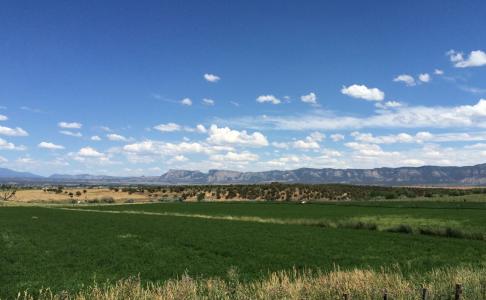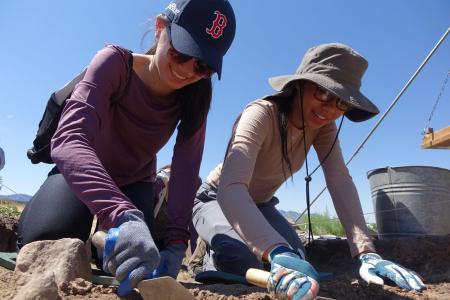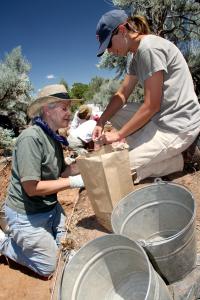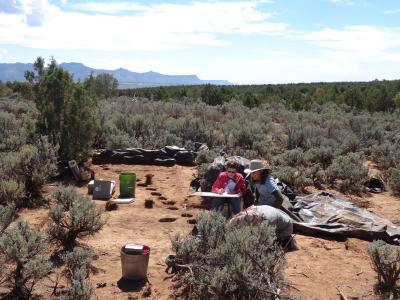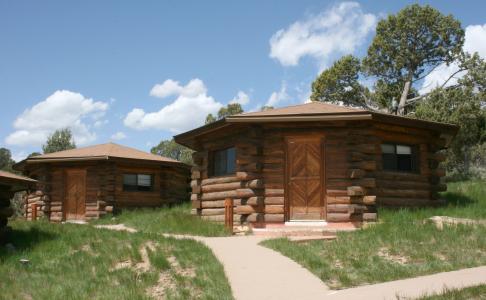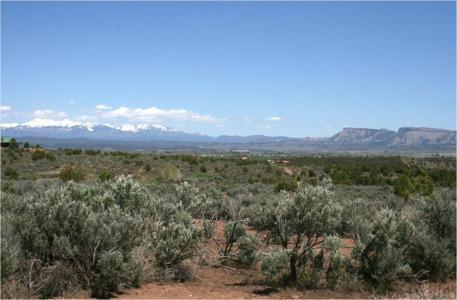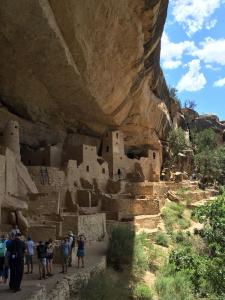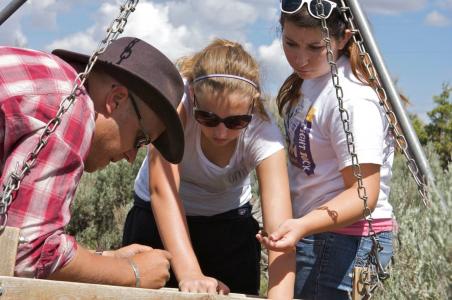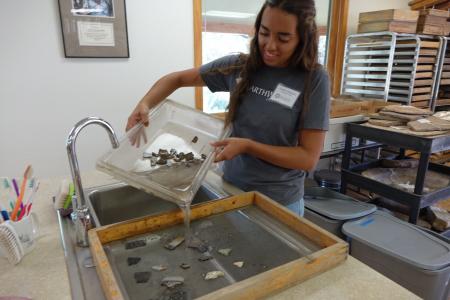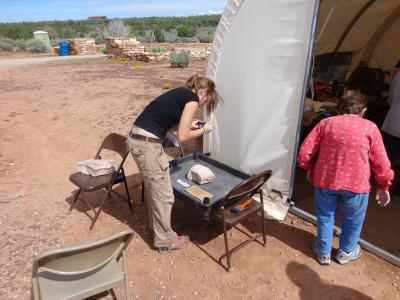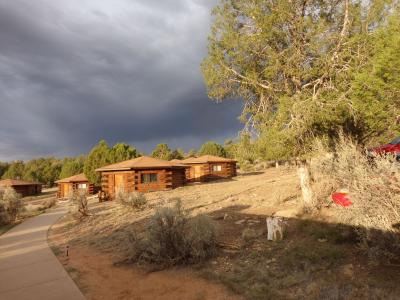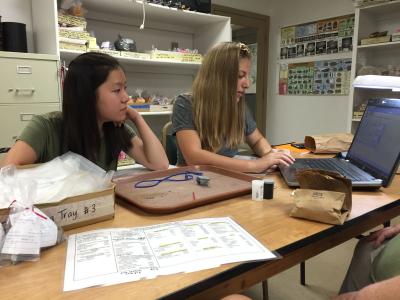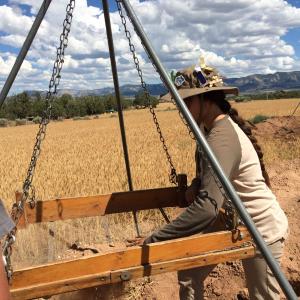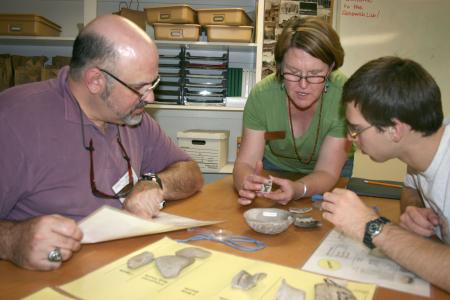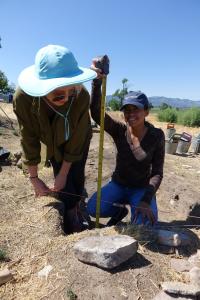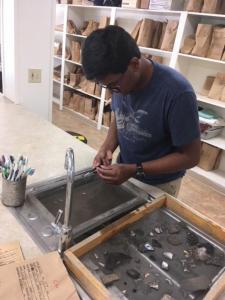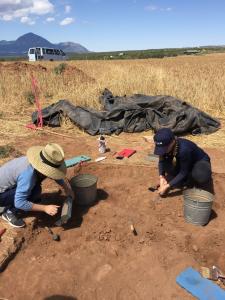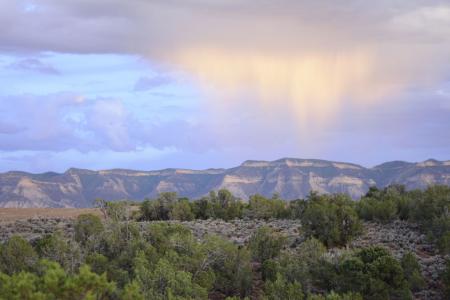The Research
Spectacular buildings known as great houses were constructed in Chaco Canyon in present-day northwest New Mexico between A.D. 800 and 1140. Collectively, these great houses were the densest concentration of the largest buildings found anywhere in the ancestral Pueblo world. The intricate Chaco regional system, a halo of Chaco influence spanning 250 miles in each direction from the Canyon, was likely based upon social power concentrated in the hands of the people who occupied the great houses in Chaco Canyon. Although the exact nature of this power is not well understood, it was most likely derived from control over material and ideological resources such as labor, farmland, water resources, material goods (including exotic goods), and ritual knowledge.
One of the most interesting, but unresolved, questions about Pueblo history is the nature and extent of Chaco influence north of the San Juan River. How did Chaco influence extend into Southwest Colorado? What effect did a 50–year drought has on environmental resources and sustainability in this region and how did the residents respond to a changing climate?
There is much to be learned from the great houses in this unique region. Data collected during this project will allow researchers to gain a greater understanding of resource sustainability, the natural and cultural impacts of environmental downturns, ancient communities and regional systems, migration, and the relationship between humans and their environment.
By understanding how the people of the ancestral Pueblo communities mediated the “A.D. 1130–1180 drought” and dealt with other environmental changes, researchers might be able to better plan for the region in the future.
Research Aims
On this expedition, you’ll focus on the Chaco great houses uncovered in Southwest Colorado. The Earthwatch scientists, working with the Crow Canyon Archaeological Center, are pursuing four major goals:
- To gather diagnostic data from artifacts, the position of layers of archaeological remains, and architecture to date each period of occupation.
- To assess the identity of migrants through the evaluation of architectural production and availability of non-local artifacts.
- To evaluate the site’s role as a community center, how the great houses related to each other in the Lakeview community and the Chaco regional system, and determine how its role may have changed through time.
- To collect tree-ring, archaeobotanical, faunal, and pollen data to assess how growing populations affected the surrounding environment and how the A.D. 1130–1180 drought affected resource availability and sustainability during the Chaco-to- post-Chaco transition.
The Crow Canyon Archaeological Center partners with schools, private landowners, and American Indian consultants to ensure that this project has a broad impact. Not only are we working to preserve and learn from the archaeological record, but we are also providing Pueblo people living today with the means to strengthen their connection to their history. The significance of this research transcends local communities.
How You Will Help
As a participant on this project, you’ll investigate an ancestral Pueblo settlement in an area called the Lakeview community, which has spectacular views of Mesa Verde and the mountains. You’ll help with the following:
- Excavate Ancestral Pueblo Households: Alongside archaeologists, you’ll use trowels and brooms to carefully remove dirt and help sift through the earth that’s been removed. You’ll have a chance to work in different parts of the site—in household structures, middens (trash deposits), and extramural activity areas.
- Lab Work: You’ll help process artifacts recovered from our excavations—pottery, lithics (chipped stone), ground stone, animal bone, and other forms of material culture—which includes the crucial work of washing, sorting, cataloging, and labeling them.
- Conducting Surface Surveys: You’ll explore potential sites, looking for surface evidence of ancient human use such as pottery sherds on the ground.
- Conducting Electrical Resistivity Surveys: Remote sensing in archaeology uses geophysical techniques to identify features below the ground’s surface. These non-destructive and non-intrusive techniques create maps of the subsurface before we begin actual excavation. Remote sensing techniques can help identify areas of archaeological significance before we invest in labor-intensive excavations, and can also help us spot features that may have been overlooked by standard survey techniques. By measuring how electrical currents pass through the ground, we can get an idea of what sorts of materials are buried beneath, because different materials conduct or resist electrical currents to different degrees. This activity is dependent on weather conditions.
Life in the Field
The expedition will begin with a project orientation, a site tour, and instructions on how to excavate, screen, and collect data. Archaeological fieldwork requires hiking a short distance to reach the site, lifting buckets of dirt, kneeling on the ground, and working at an elevation of 6,200 feet. You can work at your own pace, but you’ll enjoy the experience much more if you’re in good physical shape.
ITINERARY
Weather and research needs can lead to changes in the daily schedule. We appreciate your cooperation and understanding.
Day 1: Arrival
- 2:30 p.m. Rendezvous at Durango airport or Crow Canyon Archaeological Center if driving
- 4:00 p.m. Latest arrival at Crow Canyon (for those driving themselves)
- 4:30–6:15 p.m. Welcome reception and dinner on campus
- 6:15–7:30 p.m. Introduction to the project, the weekly schedule, the research objectives, and campus facilities.
Days 2–3: Fieldwork Days
- 7:30–8:30 a.m. Breakfast on campus
- 8:30–4:30 p.m. Travel to the project area; fieldwork, break for lunch from noon to 1:00 p.m.
- 4:30–5:30 p.m. Free time (shower, relax, etc.)
- 5:30–6:15 p.m. Dinner on campus
- 6:15–7:30 p.m. Evening program lecture
- 7:30 onward Free time
Day 4: Lab Day
- 7:30–8:30 a.m. Breakfast on campus
- 8:30 a.m.–noon Lab work: washing, sorting, identifying, and labeling artifacts. Participants are also free to relax on campus or visit area attractions.
- 12:00–1:30 p.m. Lunch on campus
- 1:30–4:30 p.m. Work in the laboratory washing, sorting, identifying, and labeling artifacts
- 4:30–5:30 p.m. Free time (shower, relax, etc.)
- 5:30–6:15 p.m. Dinner on campus
- 6:15–7:30 p.m. Evening program lecture or activity
- 7:30 onward Free time
Days 5–6: Fieldwork Days
- See Days 2–3 above.
- Day 6 will include a research wrap–up session.
Days 7–8: Recreational Days
- One-week “a” team members will depart on Day 7.
- One-week “b” team members will arrive on Day 8.
- Saturday: Mesa Verde National Park or other archaeological site.
- Sunday: Canyon of the Ancients Visitors Center and Museum and Escalante Pueblo. There will also be an opportunity to do laundry at a Laundromat in Cortez on Sunday.
Days 9–13: Fieldwork and Lab Days
- Similar to Days 2–6
- Day 13 will include a wrap-up session.
Day 14: Departure
- Depart between 8:30 a.m. and noon.
Recreational Time: On one evening, you can choose to stay at the accommodations and rest or join Crow Canyon archaeologists for an activity. For those joining the expedition for two weeks, a Saturday excursion to Mesa Verde National Park or another archaeological site will be offered.
Driving: If you have driven yourself to the project, you may not drive your own vehicle to, from, or for project activities, or to transport project equipment. You may choose to use your own vehicle during recreational time, but know that all driving during recreational time is at your own risk. Earthwatch discourages you from transporting other participants during recreational time. Riding in another participant’s vehicle is also at your own risk, as it is not covered under the expedition’s insurance policy.
Alcohol and Smoking: Alcohol may only be used by adults at least 21 years of age. Alcohol may not be consumed in the presence of minors. Alcohol must be kept in a locked refrigerator as per our children’s camp license. Smoking may occur in only one area of the Crow Canyon campus; this area will be discussed during the introductory presentation. Marijuana is prohibited on Crow Canyon’s campus.
Accommodations and Food
* Please note that not every expedition has couples’ or single's accommodations available. Please call or email Earthwatch to check for availability prior to reserving your space(s) on the team.
SLEEPING & BATHROOMS
You’ll get a taste of traditional Southwestern living while staying at Crow Canyon.
Adult teams will stay in Navajo-style hogans on campus. Each hogan has four single beds and one bunk bed, and between two and six participants will share it. Participants will be separated by gender unless a couple requests accommodations together (couples can stay in the same hogan if space permits). Single rooms can be accommodated only if the number of participants works out. Please request couple accommodations in advance, although they can’t be guaranteed.
Bathrooms are located in the large “super hogan,” which is divided in half to create separate areas for men and women. The super hogan has three bathroom stalls with flush toilets and four shower stalls with hot water on each side. Please conserve water when possible.
The teen team will stay in our comfortable cabins, which were constructed in 2016. The cabins have been designed to be energy efficient and to blend well with the landscape. The cabins have multiple bedrooms, each with several bunk beds. Bathrooms (with showers) are located down the hall in each cabin. The cabins are coed, but individual rooms will be separated by gender. Teen Facilitators stay in separate rooms in the cabins and provide supervision.
* Earthwatch will honor each person’s assertion of gender identity, respectfully and without judgement. For both teen and adult teams, where logistics dictate single-sex accommodations or other facilities, participant placements will be made in accordance with the gender identity the participant specified on their Earthwatch Participant form and/or preferences indicated in discussions with Earthwatch.
ELECTRICITY
The hogans have reliable electricity. You’re welcome to bring cameras and other electronic equipment. You’ll have time in the evenings to get on computers, etc.
PERSONAL COMMUNICATIONS
Crow Canyon provides wireless Internet service at no charge. One communal computer (with Internet and printer) is available in the lobby of the Gates Building on campus. One communal phone is also available; you’ll need to use a calling card for long-distance calls. Cell phone reception is good outside of the campus buildings.
DISTANCE TO THE FIELD SITE
The Haynie site, where we’ll focus our work, is located 10 miles from Crow Canyon’s campus. We’ll be transported to the project area by vans.
FOOD AND WATER
Breakfast and dinner are provided cafeteria-style in the lodge dining hall, where other Crow Canyon groups and visitors will also dine (kitchen staff will do all food preparation and clean up). You’ll be treated to delectable, healthy meals that feature hearty entrees and fresh fruits and vegetables. A salad bar and vegetable dishes are available for those who favor vegetarian cuisine.
We’ll eat picnic lunches out in the field—you’ll be able to make your own sandwiches from various breads, meats, vegetables, and cheeses as well as peanut butter and jelly, and choose from sides that include chips and fruit.
Crow Canyon’s kitchen staff will accommodate special diets upon request. Please alert Earthwatch to any special dietary requirements (e.g., vegetarian or vegan diets, diabetes, lactose or gluten intolerance, nut or other serious food allergies) as soon as possible, and note them in the space provided on your participant forms.
The following are examples of foods you may find in the field. Variety depends on availability. We appreciate your flexibility
- Breakfast: Cereal, fresh fruit, yogurt, French toast, sausage, pancakes, hash browns, toast, tea, coffee.
- Lunch: Sandwiches (turkey, ham, roast beef, provolone, cheddar, Swiss, peanut butter and jelly, lettuce, tomato, pickles) fresh fruit, chips, cookies, crackers, granola bar
- Dinner: Entrees may include stir-fry, meatloaf, lasagna, green chili stew, salad bar, enchiladas, and vegetables; vegetarian options are always available.
- Dessert: Cookies, brownies, cupcakes.
- Snacks: Fresh fruit, granola bars, cookies, and crackers
- Beverages: Water is readily available (tap water is potable), Lemonade, iced tea, hot tea, coffee
SPECIAL DIETARY REQUIREMENTS
Please alert Earthwatch to any special dietary requirements (e.g., diabetes, lactose intolerance, nut or other food allergies, vegetarian or vegan diets) as soon as possible, and note them in the space provided on your participant forms.
Project Conditions
GENERAL CONDITIONS
For weather and region-specific information, please visit Wunderground.com and search for your project location.
Essential Eligibility Requirements
All participants must be able to:
- Take an active role in your own safety by recognizing and avoiding hazards if and when they arise (including, but not limited to, those described in Earthwatch materials and safety briefings). Comply with project staff instructions and recommended safety measures at all times.
- Be able to effectively communicate to the staff if you are experiencing distress or need assistance.
- Be comfortable being surrounded by a language and/or culture that is different from your own.
- Be able to get along with a variety of people from different backgrounds and ages, often in close proximity, for the duration of your team.
- Follow verbal and/or visual instructions independently or with the assistance of a companion.
- Enjoy being outdoors all day in all types of weather (see above), in the potential presence of wild animals and insects.
- Tolerate 30°C (85°F) and higher daily temperatures and low humidity levels
- Acclimate to high elevation (6,200 feet).
- Traverse short distances of uneven terrain to reach research sites (this is an activity participants can take at their own pace).
- Get low enough to access the ground for digging and trowelling in the sediment, up to 20 times a day.
- Handle a shovel and trowel to sift through sediment, and a bucket to lift 10 to 20 pounds of dirt.
- Carry personal daily supplies such as lunch, water, and some small field equipment weighing 10 pounds or less.
- Get up into and down out of a minibus and ride, seated with seatbelt fastened, for a total of about 1.5 hours a day.
Health and Safety
EMERGENCIES IN THE FIELD
Earthwatch has a 24-hour, 7-day-a-week emergency hotline number. Someone is always on call to respond to messages that come into our live answering service.
IMMUNIZATIONS & TRAVEL VACCINATIONS
Please be sure your routine immunizations are up-to-date (for example: diphtheria, pertussis, tetanus, polio, measles, mumps, rubella and varicella) and you have the appropriate vaccinations for your travel destination. Medical decisions are the responsibility of each volunteer and his or her doctor. Visit the Center for Disease Control and Prevention or the World Health Organization for guidance on immunizations.
If traveling from countries or region where yellow fever is endemic, you must have a certificate of vaccination.
Project Risks and Precautions
Transportation
Crow Canyon staff complete drivers safety training to operate CC vehicles—only these staff members may drive the team to research and recreation destinations. Efforts are taken to minimize transportation needs, so that the group only travels when necessary. There are gravel roads in some sections of the project area, and these will be traveled at reduced speeds. Participants will be provided with seat belts and are expected to use them whenever the vehicle is in motion.
Hiking
Participants are required to engage in demanding physical activities including walking over uneven terrain. Project staff will review the participants’ physical abilities, and adjust the pace of the group as much as possible to accommodate needs. Due to the terrain, individuals with severe mobility restrictions may not be able to be accommodated.
Altitude
The field project is located outdoors at an elevation of 6,200 feet above sea level; this may create physical difficulties for those individuals residing at or near sea level.
Climate/Weather
The climate in southwest Colorado is generally dry and very sunny. Daytime summer temperatures average in the middle-to-upper 80s, though they can reach into the 90s and occasionally exceed 100 degrees. Participants must be able to tolerate long periods of sun exposure during the summer months. Measures should be taken by participants to avoid dehydration and sun exposure, such as drinking water throughout the day, covering up with full-length trousers and shirts, and wearing sunglasses and a hat with a generous brim.
Dehydration
Participants will be reminded to drink plenty of water throughout the day and to bring at least one liter of water into the field each day; to wear high-factor sunscreen and appropriate clothing, including sunglasses, a wide- brimmed hat and/or scarf; to not overwork when jet lagged or tired, and to inform a staff member when feeling tired or ill. Team will take regular breaks as needed, and monitor participants for general health at all times.
Animals
Information will be provided prior to program to ensure proper medical awareness, and prior review of allergies listed in participant forms will be undertaken by first responders at Crow Canyon.
The team will be briefed on what plants and animals should be avoided, and how to identify them.
There is the potential to encounter snakes, scorpions, mice, bees and wasps, spiders, ants, mosquitoes, ticks, and skunks.
Project tasks/ Equipment
Instruction will be provided on proper excavation technique and proper inspection of equipment to ensure safety. Adequate protective personal equipment (i.e., gloves, hats, hiking boots) should be provided by each participant. Kneeling pads will be provided for participant use.
Travel Planning
RENDEZVOUS LOCATION: Durango-La Plata County Airport, Durango, CO or Crow Canyon Archaeological Center, CO
* Additional information will be provided by Earthwatch to meet your team. Please do not book travel arrangements such as flights until you have received additional information from Earthwatch.
ABOUT YOUR DESTINATION
Earthwatch strongly recommends that travelers investigate their destination prior to departure. Familiarity with the destination’s entry/exit requirements, visas, local laws, and customs can go a long way to ensuring smooth travel. The U.S. Department of State's Traveler’s Checklist and Destination Guides are helpful resources. For LGBTI travelers, the U.S. Department of State's LGBTI Travelers page contains many useful tips and links.
COUNTRY AND PROJECT ENTRY REQUIREMENTS
Entry visa requirements differ by country of origin, layover, and destination, and do change unexpectedly. For this reason, please confirm your visa requirements at the time of booking and, again, 90 days prior to travel. Please apply early for your visa (we recommend starting 6 months prior to the start of your expedition). Refunds will not be made for volunteers cancelling due to not obtaining their visa in time to meet the team at the rendezvous. You can find up to date visa requirements at the following website: www.travisa.com.
If a visa is required, participants should apply for a TOURIST visa. Please note that obtaining a visa can take weeks or even months. We strongly recommend using a visa agency, which can both expedite and simplify the process.
Generally, passports must be valid for at least six months from the date of entry and a return ticket is required.
Resources
ARTICLES
- Lipe, William D. and Mark D. Varien 1999 Pueblo II (A.D. 900–1050). In Colorado Prehistory: A Context for the Southern Colorado River Basin, edited by William D. Lipe, Mark D. Varien, and Richard H. Wilshusen, pp. 242–289. Colorado Council of Professional Archaeologists, Denver.
- Ryan, Susan C. 2010 The Occupational History of Albert Porter Pueblo during the A.D. 1130–1180 Drought. Kiva 75:303–325.
BOOKS
- Noble, David Grant (editor). The Mesa Verde World: Explorations in Ancestral Pueblo Archaeology. Santa Fe: School for Advanced Research Press, 2006.
- Kantner, John. Ancient Puebloan Southwest. Cambridge: Cambridge University Press, 2004.
- Childs, Craig. House of Rain: Tracking a Vanished Civilization Across the American Southwest. New York: Little, Brown and Co., 2007.
- Varien, Mark D. Sedentism and Mobility in a Social Landscape: Mesa Verde and Beyond. Tucson: University of Arizona Press, 1999.
